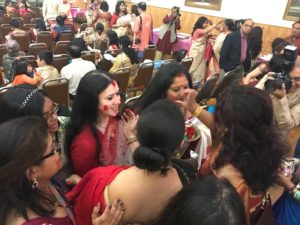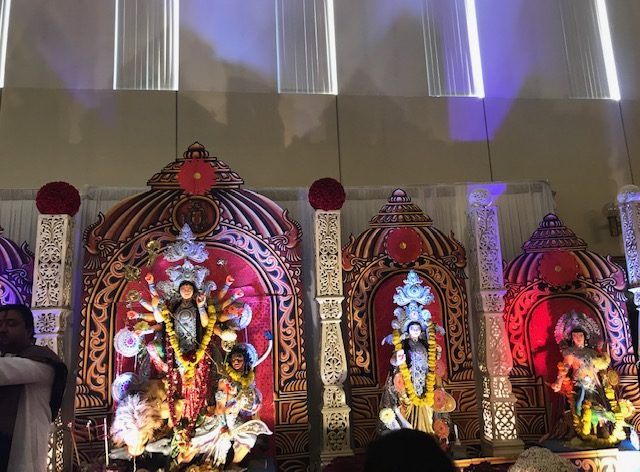DURGA IN THE DIASPORA: In New Jersey, Pujo is more about evolving with our heritage rather than merely recreating a nostalgic past
Autumn arrives ceremoniously in America. The foliage on deciduous trees approach the end of their annual tenure with shades of green morphing into hues of ochre, orange, burgundy, red and brown. They quiver in the cool, crisp air before falling and baring the trees. Although this beautiful season is but a transitory phase between the restlessness and grime of summer, and the heaviness and languor of winter, it feels strangely unencumbered. Autumn is vibrant yet mellow, flippant yet hermitic, transient yet metronomic. While it is here, it feels as if, unlike most good things, it will never end.
Autumn in America has no resemblance with autumn in Kolkata. It is a far cry from the vibrance, chaos, and mirth that accompanies the Kolkata autumn of Pujo. In New Jersey, where I live, Pujo is not nearly of the same scale as in much of Kolkata these days, but it lives vigorously within the boundaries of a quite well-defined, inclusive, thriving Bengali community. New Jersey, the state with the highest concentration of Indians in the United States, has several Bengali cultural associations, run by dedicated volunteers. The planning starts from spring, runs parallel to the organizers’ busy schedules and commitments, and culminates in celebrations at a community center, cultural center, or school auditorium, over a weekend closest to the tithi that year. Pujo is also celebrated at The Bharat Sevasram Sangha and Ananda Mandir, both of which have their resident staff, and strictly observe the ponjika nirghonto.
I find Pujo in America very similar to my para Pujo at Jodhpur Park or my grandparents’ para Pujo at Adi Ballygunge while I was growing up, where the nondescript and familiar lanes and by-lanes transformed into animated courtyards sonorous with the rhythm of the dhaak. The familiar and glowing faces of our parents, neighborhood aunts and uncles, and the paratuto dadas and didis have transposed to the familiar and glowing faces of friends, colleagues and adopted families. This old feeling of connectedness, the magical yet familiar, the new yet known, the exciting yet comforting, and the magnificent yet intimate makes me feel at home in the Pujo milieu in the US. The raucous and unbridled spirit of the Kolkata Pujo is harmoniously contained in the confines of indoor venues here. While the Pujos’ scale and grandeur in America do not hold a candle to those in Kolkata, the spirit is indomitably sustained by the expatriate Bengalis nestled in the venues for two or three days of adda, food, fashion, shopping, and cultural programs.

Adda: Every Pujo experience is shaped around the conversations with no preconceived ends or means. They flow – playful banter, harmless gossip, recycled repartees – carefree exchanges that happen among friends and acquaintances who share the warmth that lives permanently rent-free in the expatriate Bengali community. With no compulsion for pandal hopping and necessity to navigate the festive traffic, we let our hair down, literally and figuratively, sprawled in ever-expanding circles of chairs, quite symbolic of our ever-expanding networks. From chatting with the same group of friends one meets for all familial and community celebrations, to catching up with an acquaintance one may not be in touch with all year, but is sure to run into at Pujo, the inscrutable Bengali genes find a new vitality in the pujor adda.
Food: I often tell my non-Bengali and non-Indian friends that the first question a Bengali is usually asked after attending any event, from a casual visit to a friend’s home to a grand wedding invitation, is “Ki khaowalo?” The first issue that is discussed while our WhatsApp group is trying to decide on which Pujo to attend this year is, “Ki khaowabey?” It is against this “nugget” of information that all other factors are weighed, and decisions are made. The dinner menu on all days comprises quintessential Bangali food, while many Pujo committees also arrange for the distribution of the delectable “bhog.”
Fashion and shopping: The comfort of not having to walk through the city, and the safety on the streets and at the indoor venue make it logistically possible for us to wear our finest sarees and jewelry during Pujo. The more emotional motivation can be attributed to us trying to make the most of an occasion to dress up, in lieu of the many family weddings and celebrations we miss every year. Hidden thus under the sashaying folds and glistening metals is a longing for home and an effort to reclaim it, through looking and feeling good. Unlike in the past, the internet, online shopping sites, and regular trips to Kolkata have made the latest style trends accessible to non-resident Bangalis. From the traditional red and white kanjeevaram and shnidurer tip for Boron to the fashionable khaddi georgette with a backless blouse on Nobomi, Pujo fashion is the grand finale of sartorial planning and decisions we make for months. Online boutiques who roam the virtual streets of Facebook ferrying their collections all year long also find an exhibiting place at the makeshift stalls set up at the Pujo hall, and often the saree for next year’s Pujo is procured at this year’s Pujo!
Cultural programs: As the autumn evening casts its frigid spell outside the Pujo venue, the stage is set for performances by local residents, from recitations by children and dance performances by various groups and dance schools, to extensively-rehearsed plays performed by children and adults alike. Pujo organized by the cultural associations, akin to those in our paras in Kolkata, is an occasion to showcase one’s dedication to and talents in Bangla literature, music and performing arts. The night almost always culminates in performances by popular artists from Kolkata and Mumbai. In recent years I have heard live performances by Anupam Roy, Imon Chakrabarti, Rupankar Bagchi, Cactus, Dohar, and Sona Mahapatra. This year however, more than performances by Bonnie Chakraborty and Subhomita at Kallol, our Pujo destination, I am eagerly awaiting a Bijoya performance by my favorite band Chandrabindu a week later.
There is no shiuli phul, no kaashbon, no Mahalaya on radio in the home I have built thousands of miles away from the one I grew up in. But while the distance is wide, time and its machinations have afforded me bridges between my life in the US and the one I left behind in Kolkata. Pujo festivities for non-resident Bangalis is more about evolving with our heritage rather than merely recreating a nostalgic past. Our American-born children will not have the kind of childhoods we did, but many of them, including my eight-year-old son, identify as “of Bangali origin.” Whether they comprehend or take part in the rituals around Pujo is perhaps less important than their belief in being American and Bangali. Our lives and identities are not monolithic, and in the world, we are coexisting. For me, probaasher Pujo encompasses the stability and security of containing and cherishing these multiplicities. It is an annual celebratory moment when we look lovingly at what came before, eagerly at what is yet to come, and gratefully at what is.


Comments are closed.